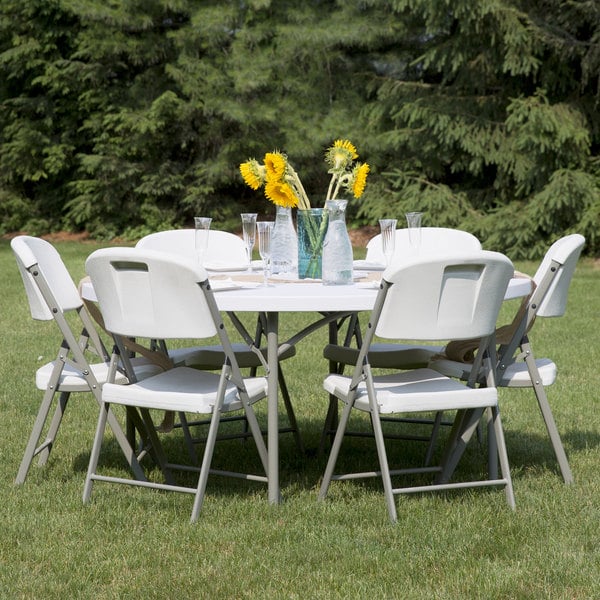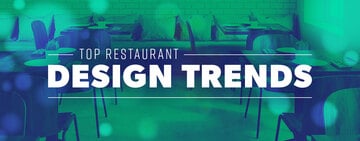How Many People Fit At a Banquet Table?
Last updated on Jul 31, 2025Janine JonesAre you worried that your guests might feel cramped at your banquet hall, buffet, or catered event? Wondering how many people each size restaurant table can comfortably seat? To create a comfortable and welcoming environment, check out our banquet table seating guide that matches banquet table sizes with how many people they can seat below.
Shop All Folding TablesWhat Is a Banquet Table?

Banquet tables are tables used at special events, like wedding receptions, catered galas, outdoor company picnics, and luncheons. They are usually folding tables that can be easily moved to create different seating arrangements in a room and quickly stored away at the end of an event.
How Big Is a Banquet Table?
The most popular average banquet table size is a 60" round table. The standard table sizes for events are 30" round tables, 24" x 24" square tables, 36" round tables, 42" round tables, 48" round tables, 54" round tables, 30" x 72" rectangular tables, 60" round tables, 30" x 96" rectangular tables, 72" round tables.
Banquet Table Sizes and Seating
Whether you work in catering or event planning, seating capacity is a common question that comes up when trying to decide the layout of a room. The following list includes the average seating capacity of the most common banquet table size.
Use this list as a guide for seating guests at round tables:
- 24" Round Table - seats 2-3 guests
- 30" Round Table - seats 3-4 guests
- 36" Round Table - seats 4 guests
- 42" Round Table - seats 4-5 guests
- 48" Round Table - seats 5-6 guests
- 54" Round Table - seats 6-7 guests
- 60" Round Table - seats 8 guests
- 72" Round Table - seats 10 guests
Use this list as a guide for seating guests at square and rectangular tables:
- 24" x 24" Square Table - seats 2 guests
- 30" x 72" Rectangular Table - seats 6-8 guests
- 30" x 96" Rectangular Table - seats 8-10 guests
Seating Capacity Chart
We’ve created an easy-to-read seating chart to help you quickly navigate the seating capacity by banquet table dimensions. These suggested sizes are accepted industry-wide, but your specific needs may differ. For example, if you are serving a complex, multi-course meal, you may want to choose the next largest size table.

Banquet Table Seating FAQs
We answer the most frequently asked folding table sizing and seating questions below:
How Many People Can Sit at a 60 Inch Round Table?
You can fit 8 seats at a 5 foot round table (60 inches round).
How Many People Can Sit at a 6 Foot Table?
If you have a 6 foot round table (72 inches), you can seat 8-10 people at the table. If it is a 30 inch by 72 inch rectangular table, 6-8 seats will fit around the table, with 3 chairs on either side and 1 chair at either end.
How Many People Can Sit at a 8 Foot Table?
For an 8 foot, or 30 inch by 96 inch rectangular table, you can comfortably sit 8-10 people, with 4 chairs on either side and 1 chair at either end.
We also offer these other banquet-related products to satisfy all of your catering or event hall needs:
Related Resources

Top Restaurant Design Trends of 2025
In the same way that foodservice trends shift from year to year, the design landscape is constantly evolving. As we look ahead to 2025, new trends are emerging that will shape the commercial spaces of tomorrow. From structural changes to decorative elements, businesses are embracing innovative design concepts to create unique and engaging environments. We’ll explore the latest design trends that are set to define the commercial landscape in 2025. Structural Design Trends Decor Design Trends Structural Design Trends Restaurants are giving their establishments a facelift to keep up with upcoming trends, from theming to smart technology. Here are the major structural changes we’re predicting for 2025: <figure> </figure> Multi-Themed Spaces One of the most exciting design trends of 2025 is the rise of multi-themed spaces in restaurants. Gone are the days of a single, monotonous dining area. Instead, establishments are embracing the concept of creating multiple dining spaces, each with its unique theme. From cozy rustic corners to sleek and modern lounges, these multi-themed spaces offer customers a variety of experiences within a single restaurant. Whether it's a vibrant tropical oasis or an elegant vintage-inspired room, these themed cafes and restaurants cater to different preferences and create a memorable dining experience for their customers that will have them coming back to try a new vibe. <figure> </figure> Eatertainment Eatertainment is a growing trend in the commercial industry, combining dining experiences with entertainment. In 2025, we can expect to see more restaurants and venues adopting this concept to attract customers. Eatertainment establishments often feature interactive elements, such as game room equipment, virtual reality games, live performances, or themed dining experiences. These venues aim to provide a memorable and immersive experience for guests, creating a unique atmosphere that sets them apart from traditional dining establishments. With the rise of social media and the demand for experiential dining, adding eatertainment elements, like cornhole, air hockey, and video games can help you attract customers in 2025. <figure> </figure> Luxury Bathrooms Luxury bathrooms are becoming increasingly popular in commercial settings, offering a high-end and indulgent experience for customers. In 2025, design trends in luxury bathrooms include sleek and minimalist fixtures, such as floating vanities and wall-mounted toilets, which create a clean and modern aesthetic. High-tech features, such as smart mirrors with built-in lighting and hands-free faucets, toilets, and hand dryers are also on the rise, providing convenience and customization. Additionally, natural materials like marble and stone are being used to create a sense of opulence and luxury. With these design elements, commercial establishments can create a luxurious bathroom experience that leaves a lasting impression on their customers. <figure> </figure> Embedded Tech Embedded technology is one design trend that is set to revolutionize the commercial landscape in 2025. With the rise of contactless experiences, QR codes have become a staple in many businesses, allowing customers to easily access menus, promotions, and more with just a scan. Another convenience that customers can expect is the availability of outlets at tables, ensuring that they can charge their devices while enjoying their meal or working remotely. Additionally, a strong Wi-Fi signal is becoming increasingly important, as customers rely on a stable internet connection for various purposes. With the rise of restaurant automation, ordering tablets are becoming more prevalent, allowing customers to browse menus, place orders, and even pay without the need for physical interaction with waitstaff. Upgrade your kitchen with VersaHub smart equipment. Decor Design Trends Your restaurant dining room is the place your customers will be spending most of their time. Make it eye-catching and inviting with some of these trends in 2025: <figure> </figure> Instagram Worthy The design trends of 2025 are all about capturing attention and creating memorable experiences. One trend that has taken over social media is Instagram-worthy decor. Neon signs are making a comeback, adding a vibrant and eye-catching element to any space. They can be customized with catchy phrases or logos, instantly becoming a focal point for photos. Playful wallpaper is also on the rise, with bold patterns and colors that make a statement. From floral motifs to geometric shapes, these wallpapers transform walls into works of art, perfect for creating Instagram-worthy backdrops. These design elements not only enhance the aesthetics of a space but also provide businesses with the opportunity to engage with their audience through social media platforms. <figure> </figure> Whimsical Themes Whimsical themes are set to take the commercial design world by storm in 2025. With a focus on bolder and more imaginative concepts, these themes are often based on books, movies, time periods, or locations. From fantastical fairy tales to retro-inspired aesthetics, whimsical themes offer a playful and enchanting atmosphere that captivates customers and creates memorable experiences. Expect to see vibrant color schemes, quirky decor, and unexpected elements that transport visitors to a different world altogether. Whether it's a whimsical tea shop inspired by Alice in Wonderland or a drive-in retro diner reminiscent of the 1950s, these themes are sure to leave a lasting impression on customers. <figure> </figure> Natural Elements In the world of design, natural elements continue to be a popular choice for businesses looking to create a warm and inviting atmosphere. The natural look, characterized by the use of organic materials and earthy tones, has gained momentum in recent years and shows no signs of slowing down in 2025. Rattan, a versatile material made from palm stems, is making a comeback in commercial spaces, adding a touch of rustic charm. Wooden vertical slats are also being used to offer a modern twist to traditional wood paneling. Stoneware tableware, with its earthy textures and natural finishes, adds a touch of elegance to restaurant settings. And let's not forget about cement furnishings, which bring an industrial, yet organic feel to any space. Incorporating these natural elements into your business's design can help create a unique and inviting ambiance that customers will love. <figure> </figure> Ceiling Decor From floor to ceiling, the design trends of 2025 are pushing boundaries. No longer limited to just the walls, businesses are now embracing the opportunity to make a statement with their ceilings as well. From intricate patterns and vibrant colors to unique lighting fixtures and suspended art installations, the ceiling is becoming an integral part of the overall design aesthetic. Consider using creative patterns, plants, bold colors, and unique textures to add a touch of personality and style to any commercial space. Whether it's a restaurant, hotel, or office, this trend allows businesses to create a truly immersive and captivating experience for their customers. So, if you're looking to stay ahead of the game in 2025, don't forget to look up and explore the endless possibilities of ceiling decor. What Can We Take Away from This Year's Restaurant Design Trends? In all of these emerging design trends, there are a few general takeaways that you should keep in mind when updating your restaurant's design and layout. Customers Want Experiences Your restaurant is no longer just about the food you serve but the experience you create for the customer. Whether it is by providing multiple themes, offering games, or upping the incorporation of technology in your space, customers want to be immersed in the environment of your establishment so that they can create lasting memories with their friends and family. Stand Out from the Crowd As we come out of post-pandemic life with threats of a recession, customers are seeking escapism with vibrant experiences. They want to go to locations that engage their senses and are worthy of their social media accounts. In most cases, this means the bolder the better. 2025 is the year to lean into your vibe and make your business the place people are talking about. Trends in the foodservice industry are constantly changing and adjusting based on the needs of society and what's popular with consumers. Whether you choose to completely remodel or do a few updates to stay trendy and accessible, your diners will notice your efforts come 2025!

How Restaurant Color Schemes Affect Your Customers
The colors you use to decorate your foodservice establishment can influence how long customers spend in your operation and how they feel. Colors can make your customers happy, boost their appetite, increase table turnover, and make your dining space seem more spacious. However, they can also negatively affect your customers, so it's good to understand how your interior color choices affect your restaurant's message. We've compiled a list of the best color palettes for different restaurant types and how to utilize color psychology when designing your dining room. 5 Color Scheme Ideas Now that you know how colors will affect your customers, you need to understand which colors go together and how to make a pleasing color scheme. For readers that don't have much interior decorating experience, we created a list of some versatile and popular color schemes to give you an idea of what colors go together. Here are five interior color scheme ideas: 1. Light Color Scheme Colors: Ivory, beige, white, pale yellow, light gray A light or neutral color scheme is often used to make a smaller room look bigger than it is. Additionally, light colors evoke a leisurely and relaxing atmosphere and are not visually distracting, which makes them an excellent choice for traditional sit-down restaurants, bistros, and upscale eateries. Due to the relaxed and comfortable feeling this color scheme evokes, it's not ideal for restaurants that want a high turnover rate. 2. Dark Color Scheme Colors: Crimson, brown, purple, navy, dark green A dark color scheme is excellent for creating intimate and romantic settings and is perfect for some bars, trendy restaurants, and taverns. However, using too many dark colors or too dark of a shade can make your space feel cramped and claustrophobic. Try balancing out a dark wall color by adding contrast like bright art, greenery, florals, and plenty of ambient lighting to make it cozy. 3. Warm Color Scheme Colors: Yellow, terracotta, orange, red, gold Warm colors are bright, exciting, and visually stimulating for guests. Because these colors are so bright, they can become overwhelming after a long period. Warm colors help increase your turnover rate and are ideal for high-volume establishments like fast-casual eateries, buffets, or fast food restaurants. 4. Earthy Color Scheme Colors: Brown, olive green, beige, umber, dark orange An earthy color palette features colors found organically in nature, including shades of brown, green, and some neutral colors. An earthy color scheme is ideal for relaxed and welcoming environments like cafes, bars, and trendy restaurants. Additionally, color schemes with predominately green and brown colors are excellent choices for menus focused on organic and natural foods. 5. Pastel Color Scheme Colors: Sky blue, pink, light yellow, lavender, pale green The pastel color scheme is soft and delicate, making it great for sweet shops, bakeries, and cafes. Because these colors are very light, they have an almost neutral tone that can fit in with most types of decor. This color scheme can create a calm, sophisticated aesthetic with the right balance. To avoid designing an atmosphere that reads too youthful, contrast with neutral shades such as white and light gray or dark wood tones. The Psychology of Colors Because various colors can affect your guests in different ways, they are powerful tools for shaping how your customers interact in your restaurant and with your menu. It also means that you can't just choose colors for your walls and decorations arbitrarily, and you'll have to use thought when choosing your restaurant's color scheme. Here is a brief summary of how common colors affect your customers and which types of establishments might utilize them: Red Red increases your guests' heart rates and can make them hungry. It can also make your guests eat quickly and leave, which is useful for increasing your table turnover rate. Establishments that should use the color red: Fast food restaurants Fast casual restaurants Establishments that want a high table turnover Orange Orange makes people feel happy and cheerful. It's also excellent for establishments that serve desserts or unhealthy food because it makes people content and less likely to feel guilty for eating poorly. Establishments that should use the color orange: Fast food restaurants Ice cream shops Casual eateries Yellow Some shades of bright yellow have a similar impact as orange, making people happy and content. Generally, yellow is very vibrant and exciting, so it's not an ideal choice for relaxed environments. Establishments that should use yellow: Fast casual restaurants Ethnic eateries Bistros Cafes Green Earthy tones like green are very relaxing and comforting. Green is found commonly in nature, making it an excellent choice for establishments that serve healthy and natural foods. Establishments that should use the color green: Health food stores Salad bars Vegetarian and vegan restaurants Brown Brown is an earthy color that helps guests relax and feel comfortable. It can also give customers a sense of support and stability, and it can even convince guests to come back as repeat customers. Establishments that should use brown in their decor: Coffee shops Bistros Contemporary restaurants Bars Blue Blue is a color that most restaurants should avoid. It's not commonly found naturally in food, and it can cause your customers to lose their appetites. Additionally, if you have bright blue walls, the shade of blue can reflect onto your food and make it look less appetizing. Blue reduces customers' appetites, but it makes them thirsty. Establishments that should use blue for their interior design: Coffee shops Bars Cafes Nightclubs Seaside restaurants White White gives your space a relaxed and leisurely feel. The color evokes a sense of cleanness and freshness and can make a small space seem larger. However, too much white can make your dining area look sterile. Avoid this by using creamy, off-white colors and contrasting accent decor. Establishments that should incorporate white into their decor: Small restaurants and bistros Upscale eateries Banquet halls Wedding venues Black Since it's not a common food color and can be an appetite suppressant, use black sparingly and strategically. It can make the other colors in your restaurant pop and look more vibrant, but too much black can make your space look cramped and dark. Use furniture, such as metal pendant lights or dining chairs, to add black accents to neutral color palettes for increased visual impact. Establishments that should use black accents in their interior: Nightclubs Bars Contemporary restaurants Menu Color Schemes Your restaurant's interior isn't the only place you need to be conscious about your color choice - the colors on your menu can also affect your customers. When creating a menu for your restaurant, be aware of which colors you're using and how they influence your customers' appetites and choices. Avoid unnatural colors like blue and purple and instead choose bright and vibrant colors like red and orange, depending on your restaurant's concept and style. Make sure the colors you choose for your menu complement each other and are cohesive with the colors in your dining space. For example, you wouldn't want to use a lot of bright colors on your menu if your interior uses a lot of earthy colors like brown and dark green. Choosing a restaurant color scheme is vital to your establishment's brand and perception. The choice of paint and decor colors plays a significant role in setting the ambiance of your dining area. It can create a cozy, romantic, or invigorating atmosphere, depending on the experience you want to provide to your customers.

Restaurant Dining Room Layout
The layout of a restaurant dining room can have a massive impact on customer experience. The layout should reflect the overall theme and concept of a restaurant while maximizing seating capacity, creating a comfortable and inviting ambiance, and optimizing traffic flow. By carefully planning the dining room layout and investing in the appropriate restaurant furniture, restaurant owners can create a space that is both functional and aesthetically pleasing, ultimately contributing to the overall success of the establishment. Restaurant Floor Plan Regulations When designing a restaurant dining room layout, it is essential to adhere to restaurant floor plan regulations to ensure a safe and efficient space for both customers and staff. Kitchen to Dining Ratio Health codes often dictate the ratio of kitchen space to dining area. This ensures that the kitchen has adequate space for food preparation, storage, and cleaning, which is crucial for maintaining food safety standards. A common guideline in the industry is to allocate approximately 60% of the total space to the dining room and the remaining 40% to the kitchen. By adhering to this ratio, restaurant owners and operators can optimize workflow in the kitchen, minimize congestion, and promote a smooth service flow. Occupancy Limits Every restaurant must comply with occupancy limits set by local building codes and fire regulations. These limits are determined based on the size of the dining area and the prescribed unit of area per person. A fire marshal may also be needed to determine the occupancy load as part of the inspection for restaurant permits and licenses. The following are the average allotted square feet per customer by service type: Banquet: 10-11 sq. ft. per person Fine Dining: 18-20 sq. ft. per person Full-Service Restaurant Dining: 12-15 sq. ft. per person Counter Service: 18-20 sq. ft. per person Fast Food: 11-14 sq. ft. per person Table Service at Hotel/Club: 15-18 sq. ft. per person Once you’ve determined your occupancy limit, you’ll want to factor in a comfortable amount of elbow room. Elbow room refers to the amount of space between tables, ensuring that guests have enough personal space to dine comfortably without feeling cramped. Use these measurements as a guideline: 18”-20” between occupied chairs 42”-60” between square tables 24”-30” between corners of diagonal tables ADA Compliance The Americans with Disabilities Act (ADA) requires restaurants to be accessible to individuals with disabilities. It is essential to provide clear pathways throughout the dining room that are at least 36 inches wide to accommodate wheelchairs and other mobility aids. Ensure that there are no obstructions or obstacles that could impede the movement of individuals with disabilities. Designate specific seating areas that are easily accessible to customers with disabilities. These areas should have tables at a height that accommodates wheelchairs and sufficient space for maneuvering. Additionally, ensure that there is a mix of seating options, including tables with removable chairs to accommodate individuals with different needs. Number of Dining Spaces Before beginning your restaurant dining room design, decide whether you want one open space or several smaller rooms. Some restaurant styles may excel with one large room, while others need additional dining areas to accommodate private parties. Multiple Rooms Multiple dining rooms offer a versatile approach to restaurant design. By dividing the space into separate rooms, each area can cater to different types of diners or events. For example, a fine dining area can be separated from a casual dining space, providing guests with diverse ambiance options. Additionally, multiple rooms allow for better control of noise levels and can create a more intimate dining experience. Here are some benefits of choosing a multi-room floor plan: Easier to anchor tables for consistent restaurant seating layout Perfect for positioning tables along walls or windows Allow for room decor, themes, or customization Create private dining options with controlled volume Option to host private parties in a secluded room with controlled volume The following are some things to consider before going with a multiple-room layout for your restaurant: Potentially more challenging for wait staff to navigate or hosts to gauge available tables May be less likely to accommodate very large parties or events Permanent walls limit future renovations Open Room An open room layout is characterized by a single, large dining area without physical barriers separating different sections. This design fosters a sense of community and encourages interaction among diners. Open room layouts are often preferred in casual dining establishments or those aiming for a more relaxed atmosphere. This layout can also make it easier for staff to navigate the space and provide efficient service to customers. These are the benefits of an open dining room layout: Ideal for portable tables, away from fixtures and walls Anchored seating possible against walls, windows, or columns Enable customers to enjoy the entire room, visually and acoustically Can accommodate very large parties Temporary partitions or dividers on casters can break up the room as needed Consider the following if you’re planning on choosing an open room concept: Can become a loud environment, not conducive for conversation Decor and ambiance could be lost or limited in the large room Could create aisle traffic, making it difficult for wait staff to navigate Bar Seating Incorporating bar seating into your restaurant dining room layout is a popular choice for establishments looking to cater to solo diners, couples, or those looking for a more casual dining experience. Bar seating can provide a more interactive dining experience, allowing customers to engage with bartenders or watch chefs in action. Additionally, bar seating can be a great option for customers looking for a quick bite or a place to enjoy a drink before or after their meal. Adding bar seating to your layout can be beneficial for your restaurant in the following ways: Allows you to accommodate more customers in your restaurant, especially during peak hours Fosters engagement between customers and staff Popular choice for solo diners or guests looking for a quick meal Customers can receive quicker service as they are in close proximity to the bartender or service staff You’ll want to consider the following if you’re thinking of using bar seating in your establishment: Casual nature of bar seating may not align with your ambiance or theme May not provide the same level of comfort as traditional dining chairs May require additional staff to manage the bar area, increasing operational costs and staffing requirements Restaurant Dining Room Furniture One of the key elements to consider when designing your restaurant dining room is the selection of appropriate furniture. The furniture you choose can greatly impact the overall ambiance and functionality of the space. By carefully selecting the right mix of tables, chairs, high tops, and booths, you can create a dining room layout that not only looks inviting but also enhances the overall dining experience for your customers. Here are some important considerations when it comes to restaurant dining room furniture: Tables and Chairs Tables and chairs are essential components of any restaurant dining room. The size and shape of the tables should be chosen based on the type of dining experience you want to offer. Round tables are great for encouraging group conversations, while square or rectangular tables are more suitable for maximizing space efficiency. Chairs should be comfortable and sturdy, providing guests with a pleasant dining experience. Booths Booths are a classic choice for restaurant seating. They offer privacy and comfort for guests, making them ideal for intimate dining experiences. Booths can also help maximize space utilization, especially in smaller dining rooms. Whether you opt for single booths, double booths, or circular booths, they can add a touch of coziness and style to your restaurant's ambiance. High Tops High top tables are a popular choice for casual dining establishments or bars. They are taller than traditional dining tables, allowing guests to sit at a higher level. High tops are great for creating a more relaxed and social atmosphere, perfect for customers looking to enjoy drinks or small bites. Restaurant Dining Room Layout Considerations There are several key considerations that need to be taken into account when preparing a dining room to ensure a functional and inviting space for customers. Here are some important factors that can impact your process: Traffic Flow: Establishing a clear and efficient traffic flow pattern is essential to prevent congestion and allow for smooth movement of both customers and staff throughout the dining room. Table Arrangement: The arrangement of tables should be carefully planned to accommodate different party sizes, promote social interaction, and optimize the use of space without making customers feel cramped. Ambiance and Atmosphere: Consider the overall ambiance and atmosphere you want to create in the dining room, including factors such as restaurant lighting, decor, music, and color scheme to enhance the dining experience for customers. Functional Zones: Divide the dining room into functional zones such as dining, waiting, and bar areas to create a well-organized space that caters to the needs of both customers and staff. Restrooms: Make sure restrooms are easily accessible from the dining room and up to ADA standards. Restrooms should be equipped with proper signage and lighting for clear visibility. Staff Efficiency: Consider the placement of service stations, kitchen access points, and server stations to optimize staff efficiency and ensure smooth operations during busy service times. Customer Comfort: Prioritize customer comfort by providing adequate spacing between tables, comfortable seating options, and a welcoming environment that encourages customers to linger and enjoy their dining experience. Safety and Regulations: Ensure that your restaurant dining room layout complies with all safety regulations and building codes, including proper exits, fire safety measures, and ventilation requirements to protect both customers and staff. Floor Planning Software Utilizing floor planning software can greatly streamline the process when designing your dining room. Software tools allow restaurant owners and managers to create detailed floor plans, experiment with different seating arrangements, and optimize traffic flow. With the ability to visualize the layout in a virtual environment, adjustments can be made easily to enhance the overall dining experience for customers and improve operational efficiency. Some industry favorites include: SmartDraw Floorplanner RoomSketcher CAD Pro Canva A well-designed restaurant dining room layout is crucial for creating a positive dining experience for customers. Factors such as table arrangement, traffic flow, and ambiance play a significant role in maximizing efficiency and customer satisfaction. By carefully planning and organizing the layout of your dining room, you can enhance the overall dining experience and ultimately increase customer retention and profitability. For more products related to this restaurant dining room layouts, check out our restaurant patio furniture, commercial decor, and host stands.









